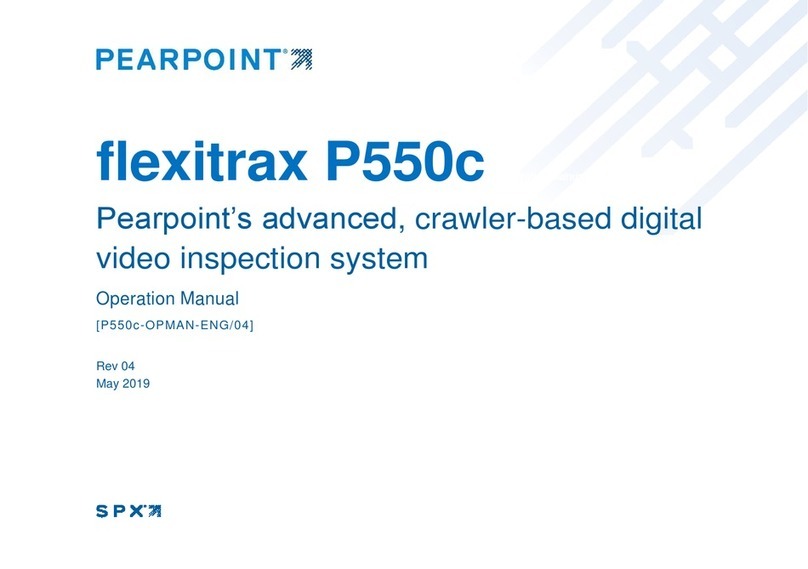1918
Schnellstartverfahren
• Installieren Sie die Steuerung, falls gewünscht, oben auf der
Kamerakabeltrommel (optional bei P341-Modellen).
• Schließen Sie die Kamera und das Zubehör nur bei ausgeschaltetem
Gerät an das Schubkabel an.
• Verbinden Sie das Verbindungskabel mit den Steckverbindern auf der
Rückseite der Steuerung und an der Schubkabeltrommel.
• Stellen Sie sicher, dass eine kompatible, abnehmbare
Speichervorrichtung, die FAT32-formatiert ist, in die Steuerung
eingesetzt ist (CompactFlash-Speicherkarte oder USB-Speicherstick).
• Schließen Sie die Steuerung an die Stromzufuhr an. Kontrollieren Sie
bei Verwendung des optionalen internen Akkus, ob der Akku für die
Durchführung der Ortung ausreichend aufgeladen ist.
• Schalten Sie die Steuerung ein.
• Drücken Sie auf OK, um den Logobildschirm zu entfernen.
• Kalibrieren Sie die Position der Kamera und stellen Sie sie auf den
Nullpunkt ein. Drücken Sie auf die Funktionstaste F10 auf der Tastatur
oder gleichzeitig auf die Tasten und auf dem Tastenfeld.
• Setzen Sie die Kamera wie benötigt in das Rohr ein.
• Stellen Sie die Kameraposition bei Bedarf auf null. Dazu drücken Sie die
Funktionstaste F10 auf der Tastatur oder gleichzeitig die Tasten und
auf dem Tastenfeld.
• Drücken Sie dann auf dem Tastenfeld die Taste , um die Inspektion
aufzuzeichnen.
Geben Sie nach Bedarf die Aufgabendetails ein:
• Überprüfen Sie Ihre Angaben zu Kundenname, Standortadresse und
Inspektionsbeginn und -ende mithilfe der Tasten und . Drücken
Sie auf OK, um die Angaben zu bearbeiten, und dann erneut auf OK,
um die Änderungen zu übernehmen.
• Drücken Sie dann auf dem Tastenfeld die Taste , um mit der
Inspektionsaufzeichnung zu beginnen.
• Drücken Sie auf die Taste , um Screenshots anzufertigen (überprüfen
Sie bei Bedarf Ihre Angaben zu Kundenname, Standortadresse und
Inspektionsbeginn und -ende, wie unter Videoaufzeichnung dargelegt).
• Drücken Sie auf die Taste OK oder Enter (Eingabe), um Beobachtungen
einzugeben.
• Wenn Sie Ihren Videos Text hinzufügen möchten:
• Drücken Sie die Tasten PG UP oder PG DN auf der Tastatur oder
• Drücken Sie die Taste auf dem Tastenfeld und dann die Taste F1
(EDIT)
• Um eine Aufzeichnung zu unterbrechen, drücken Sie auf die Taste .
• Um eine Aufzeichnung zu beenden, drücken Sie auf die Taste .
HINWEIS: Entfernen Sie Wechselspeichermedien nicht während einer
Aufzeichnung oder Wiedergabe einer Aufnahme. Dies kann alle auf dem
Speichermedium bendlichen Daten beschädigen und die Steuerung
zum Absturz bringen.
Einrichtung
Kabeltrommel
Verbinden Sie das Verbindungskabel auf der Kabeltrommel mit dem
Anschluss auf der Rückseite der Steuerung und stellen Sie sicher, dass alle
Steckverbinder fest sitzen.
Netzanschlusskabel
Lösen Sie die Seitenbefestigungen und önen Sie die zwei Abdeckungshälften.
Önen Sie die Anschlussabdeckung:
1 Verbinden Sie bei Bedarf die Tastatur mit dem Tastaturanschluss.
2 Verbinden Sie die Stromversorgung (12 bis 24 VDC Bordanschluss,
Netzteil oder optionaler Akku) mit der Strombuchse.
3 Stecken Sie eine geeignete FAT32-formatierte CompactFlash-
Speicherkarte oder einen entsprechenden USB-Speicherstick ein.
Empfohlene Einstellungen des Kamerafokus
Sie müssen den Fokus Ihrer Kamera passend zum Innendurchmesser der
Rohrleitung einstellen, die inspiziert werden soll.
Platzieren Sie Ihre Kamera gemäß den Angaben in Tabelle 1 und 2 im
erforderlichen Abstand zum Zielobjekt, um eine optimale Bildqualität zu erhalten.
Verwenden Sie das Fokussierwerkzeug, das im Lieferumfang Ihrer Kamera
enthalten ist, um den Fokussierring so lange zu drehen, bis das Zielobjekt
scharf eingestellt ist.
Tabelle 1
25-mm-Kamera
Innenrohrdurchmesser Zielobjekt
mm mm
32 76
38 92
51 122
76 183
102 244
Tabelle 2
50-mm-Kamera
Innenrohrdurchmesser Zielobjekt
mm mm
51 142
76 213
102 284
152 427
203 569
229 640




























